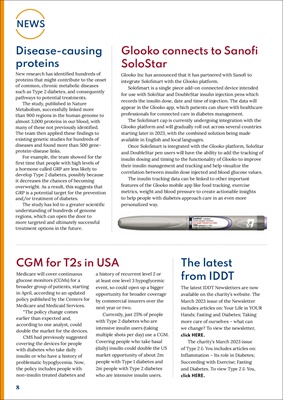
8
NEWS
Glooko connects to Sanofi
SoloStar
Glooko Inc has announced that it has partnered with Sanofi to
integrate SoloSmart with the Glooko platform.
SoloSmart is a single piece add-on connected device intended
for use with SoloStar and DoubleStar insulin injection pens which
records the insulin dose, date and time of injection. The data will
appear in the Glooko app, which patients can share with healthcare
professionals for connected care in diabetes management.
The SoloSmart cap is currently undergoing integration with the
Glooko platform and will gradually roll out across several countries
starting later in 2023, with the combined solution being made
available in English and local languages.
Once SoloSmart is integrated with the Glooko platform, SoloStar
and DoubleStar pen users will have the ability to add the tracking of
insulin dosing and timing to the functionality of Glooko to improve
their insulin management and tracking and help visualize the
correlation between insulin dose injected and blood glucose values.
The insulin tracking data can be linked to other important
features of the Glooko mobile app like food tracking, exercise
metrics, weight and blood pressure to create actionable insights
to help people with diabetes approach care in an even more
personalized way.
Disease-causing
proteins
New research has identified hundreds of
proteins that might contribute to the onset
of common, chronic metabolic diseases
such as Type 2 diabetes, and consequently
pathways to potential treatments.
The study, published in Nature
Metabolism, successfully linked more
than 900 regions in the human genome to
almost 3,000 proteins in our blood, with
many of these not previously identified.
The team then applied these findings to
existing genetic studies for hundreds of
diseases and found more than 500 geneprotein-disease
links.
For example, the team showed for the
first time that people with high levels of
a hormone called GRP are less likely to
develop Type 2 diabetes, possibly because
it decreases the chances of becoming
overweight. As a result, this suggests that
GRP is a potential target for the prevention
and/or treatment of diabetes.
The study has led to a greater scientific
understanding of hundreds of genome
regions, which can open the door to
more targeted and ultimately successful
treatment options in the future.
CGM for T2s in USA
Medicare will cover continuous
glucose monitors (CGMs) for a
broader group of patients, starting
in April, according to an updated
policy published by the Centers for
Medicare and Medicaid Services.
"The policy change comes
earlier than expected and,
according to one analyst, could
double the market for the devices.
CMS had previously suggested
covering the devices for people
with diabetes who take daily
insulin or who have a history of
problematic hypoglycemia. Now,
the policy includes people with
non-insulin treated diabetes and
a history of recurrent level 2 or
at least one level 3 hypoglycemic
event, so could open up a bigger
opportunity for broader coverage
by commercial insurers over the
next year or two.
Currently, just 25% of people
with Type 2 diabetes who are
intensive insulin users (taking
multiple shots per day) use a CGM.
Covering people who take basal
(daily) insulin could double the US
market opportunity of about 2m
people with Type 1 diabetes and
2m people with Type 2 diabetes
who are intensive insulin users.
The latest
from IDDT
The latest IDDT Newsletters are now
available on the charity's website. The
March 2023 issue of the Newsletter
includes articles on: Your Life in YOUR
Hands; Fasting and Diabetes; Taking
more care of ourselves - what can
we change? To view the newsletter,
click HERE.
The charity's March 2023 issue
of Type 2 & You includes articles on:
Inflammation - Its role in Diabetes;
Succeeding with Exercise; Fasting
and Diabetes. To view Type 2 & You,
click HERE.